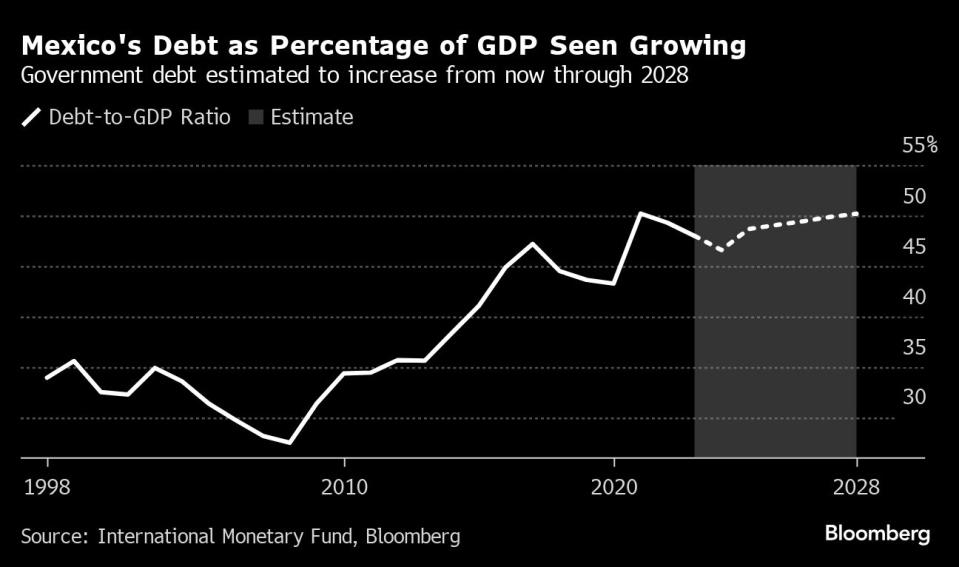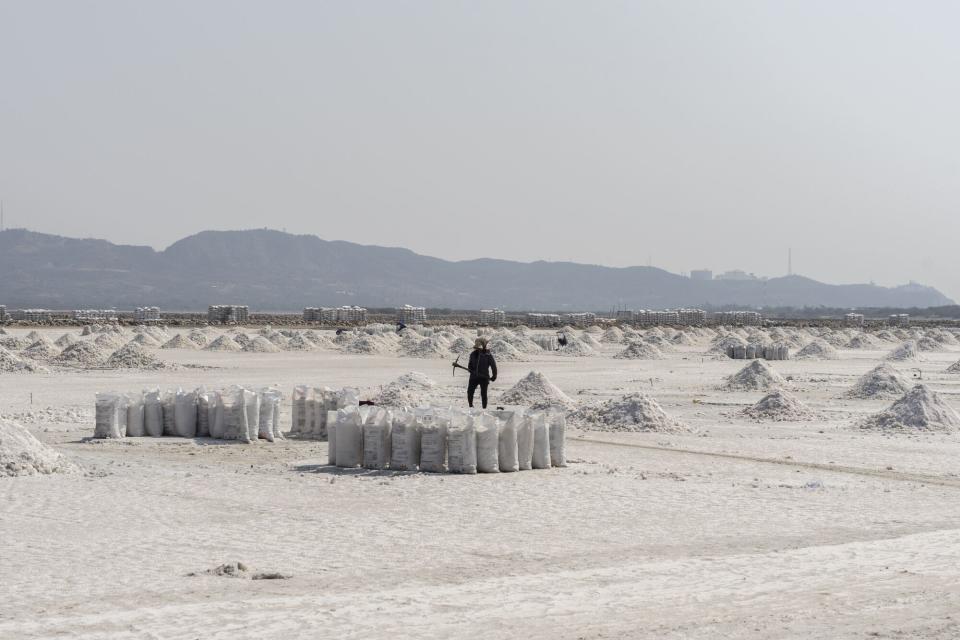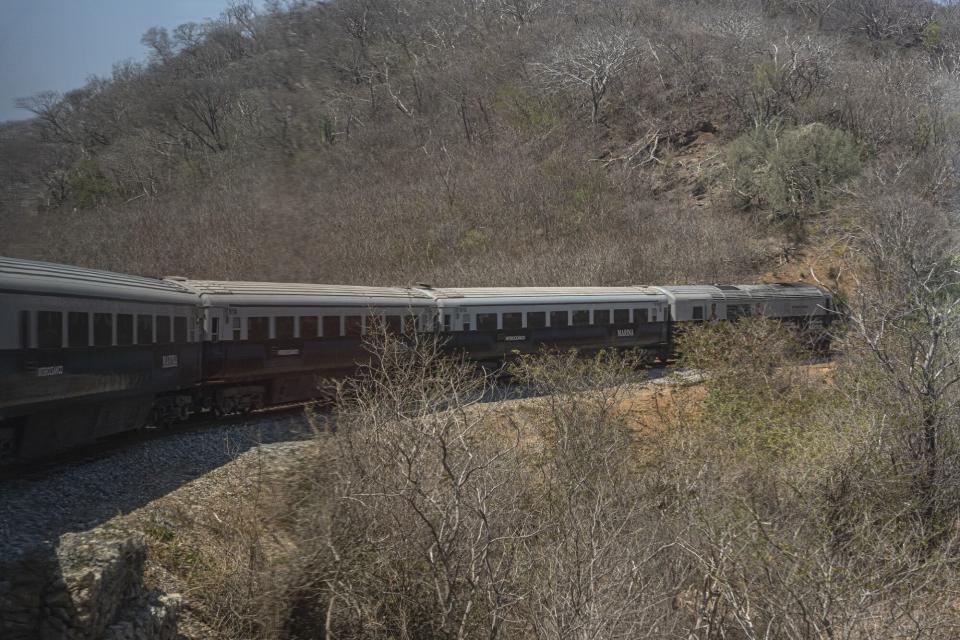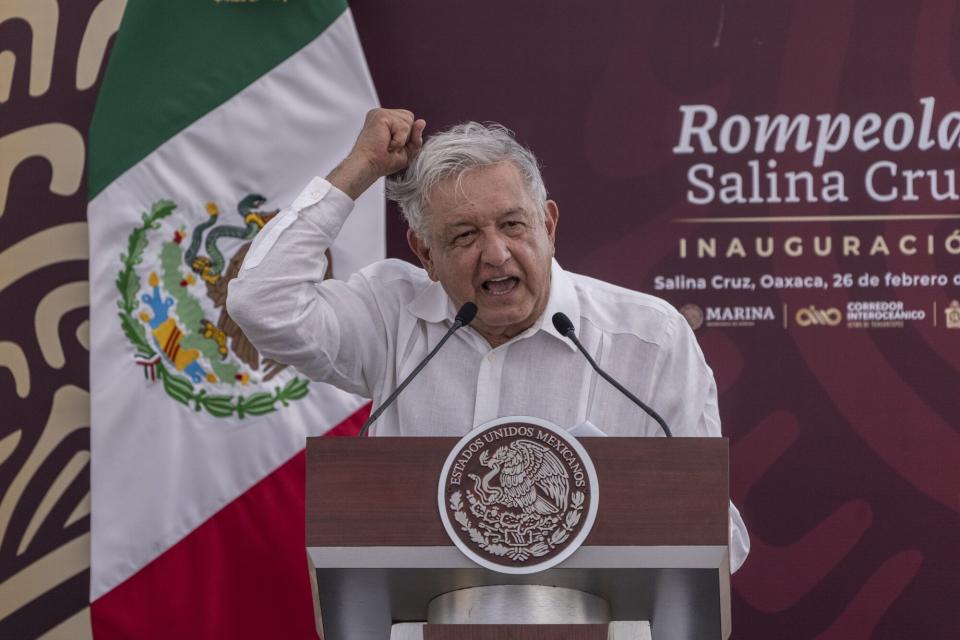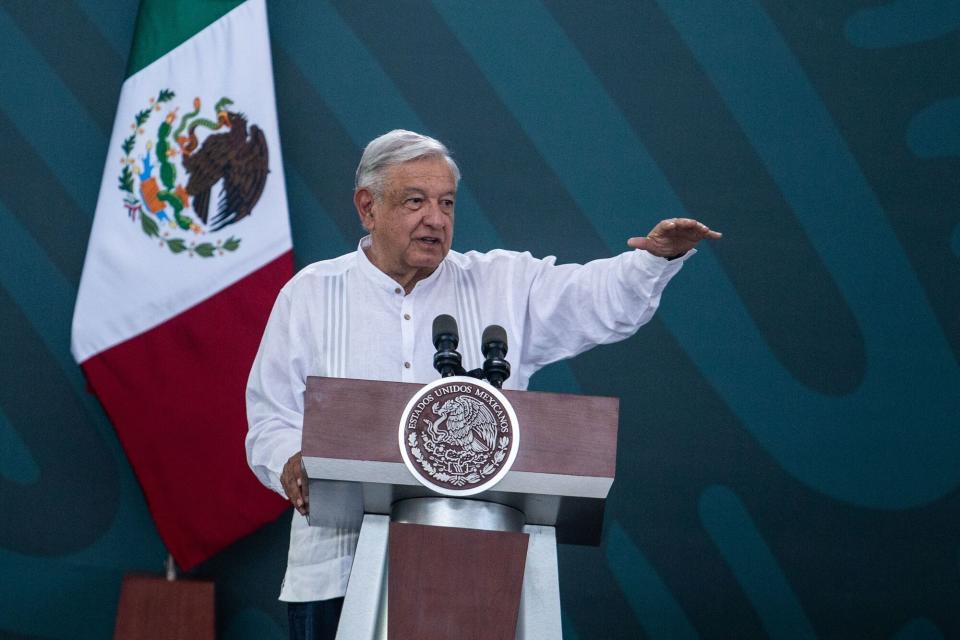AMLO Spends Like Never Before to Set Up Successor’s Victory in Mexico
- Oops!Something went wrong.Please try again later.
- Oops!Something went wrong.Please try again later.
(Bloomberg) -- Mexico’s once-frugal president has ratcheted up spending, resulting in the biggest budget deficit since the 1980s and potentially leaving his successor in a financial bind.
Most Read from Bloomberg
Texas Toll Road Takeover to Cost Taxpayers at Least $1.7 Billion
Saudi Crown Prince MBS’s $100 Billion Foreign Investment Quest Falters
S&P 500 Falls 1% as Oil Jump Spurs Flight to Bonds: Markets Wrap
Apple Explores Home Robotics as Potential ‘Next Big Thing’ After Car Fizzles
Giving Up China Is Hard, Even for Argentina’s Anarcho-Capitalist
It’s a departure for Andres Manuel Lopez Obrador, who kept a grip on the public purse all through the pandemic, as leaders elsewhere spent freely. Now, the president is boosting stipends for students and retirees, showering the state oil company with cash, and trying to get landmark construction projects finished.
The popular agenda looks set to help Lopez Obrador’s party retain the presidency with a landslide win in the June election. His party’s chosen candidate Claudia Sheinbaum, a former Mexico City mayor, has a commanding poll lead — especially in poorer southern states like Oaxaca, where public money is driving an economic boom.
Read More: Bloomberg’s Mexico Election Polling Tracker
“No other government has done as much work,” said Maria Alicia Jimenez Ibañez, a resident of Oaxaca, as she waited to buy tickets for a new train service that connects towns in the Pacific coast state to Veracruz, on the Atlantic side. “Before, the money just disappeared. Now, we’re seeing it.”
Among voters who receive social programs or whose family members do, 64% say they intend to vote for Sheinbaum, while only 21% say they will vote for the leading opposition candidate Xochitl Galvez, a far greater divide than in the general population, according to newspaper El Financiero.
For Sheinbaum, who’s flagged plans of her own including investment in health care, the concern is that funds will get harder to come by. Debt-service costs this year are expected to reach 3.7% of economic output, the most in at least three decades. Adding more spending commitments could put Mexico’s investment-grade credit rating at risk. Increasing taxes to offset that would be politically unpopular, but so would deep spending cuts.
With less debt than many peers, Mexico can afford Lopez Obrador’s final budget, according to Carlos Serrano, chief economist for Mexico at BBVA. It hasn't always been that way, with a history of leaders setting up their successors for spending crunches — a phenomenon Mexicans refer to as “crisis sexenal,” for being a problem for new presidents every six years.
Now, markets are largely unfazed by the fiscal U-turn: The peso has been the top emerging-market currency this year. S&P, Fitch and Moody’s all view Mexico’s sovereign rating as stable despite the boost in spending and the strain it might put on the country’s finances.
Still, the budget deficit comes during “a year in which things are going well,” said Serrano. “Every year we have to spend more on pensions and on servicing the debt, which is leaving the country without any margin.”
Oaxaca’s Boom
Oaxaca, long a stronghold of the opposition party known as the PRI, serves as a gauge for how the president and his Morena party have cemented control over Mexican politics.
The Morena party took over leadership of the state in December 2022. Even the previous governor defected from the PRI opposition group after his term ended and endorsed Sheinbaum — turning him into the kind of politician Mexicans call a “grasshopper” for their ability to leap to a more promising perch.
Indeed, Oaxaca’s economy grew 10% in the first nine months of last year, the most in the country, largely thanks to public spending.
Those improvements have won over locals like Jimenez Ibañez, 42, whose mother — who sells handmade totopos, a crunchy tortilla that’s a southern specialty — got enrolled in the new universal pension program.
“Even older people get paid,” she said. “We used to say, ‘where’s the help for them?’ You couldn’t find it anywhere.”
The government set aside some $43 billion for social programs this year, more than half of it for the elderly. They can collect pensions every two months, at new public banks set up all over the country. Payments have more than doubled over the six years of Lopez Obrador’s government.
Benefits like those are one major part of Lopez Obrador’s budget. The other is infrastructure investments, including a $30 billion tourist train that snakes through southern states, a nearly $20 billion oil refinery in Tabasco State, and a new airport for the capital — after he canceled plans for one started by the last president.
He also started a state-run airline, which like many projects is not expected to make money in the short term. The infrastructure works are not yet completed, which means seeing any returns on investment could take longer than originally expected.
“The bigger debate about the projects is about the return on the investment, and if perhaps the government should have used that money in other projects less likely to be developed by private companies and with higher social and economic returns,” said Felipe Hernandez, a Latin America specialist at Bloomberg Economics.
The Oaxaca train service is part of a bigger project to link Mexico’s two coasts by using the line to rival the Panama Canal for cargo, while serving as a comfortable form of transit for local residents. Major shipments have yet to begin, but the government already expanded the ports at both ends.
That helped Arturo Labias Hernandez get a better job than his old one in the local salt industry, breaking apart salt that had caked on the land and shoveling it into 50-kilo bags. He switched jobs and worked for about a year and a half building new breakwaters as part of the improvements in the port of Salina Cruz, before he came to see Lopez Obrador inaugurate them in February.
“It allowed me to do many things, like start building a house,” said the 22-year-old, whose wife has a baby on the way. “You earn less in salt than I do now, and the work is hard. There’s no shade.”
The idea is that private money will follow the public spending, as businesses invest in new industrial parks along the rail route. There’s not much sign of it yet, though Javier Aguilera Peña — whose PROISTMO company won a contract to build a park near the Atlantic end of the railway — says he’s seen “high demand” from firms that want to sell to the US’s east coast market.
Promises of Austerity
Not everyone in Oaxaca is happy about such projects. A common theme among critics is that they’re slipshod and ordered up by a faraway central government that ignores local issues.
Indigenous groups who live near the remodeled rail line, and raised concerns about the environmental effects, say they weren’t properly consulted. Salt workers protested that the breakwater would keep tidal waters from reaching the lagoons, ruining the local seasonal harvests of both salt and shrimp — though the government eased the tension by contracting them for multi-month shifts.
Farmers, already struggling with water supplies, aren’t sure they want the new factory jobs anyway, and they worry about losing access to common lands where they collect firewood for cooking and wild pitaya fruit.
But when one farmer who is a civic leader joined a protest against a planned industrial park, he was accused of setting fire to the cars of surveyors who’d come to measure the land, an allegation he denies. He was sentenced to 46 years in jail.
Jesus Luis Lopez, another local farmer, says he appreciates the way Lopez Obrador is distributing public cash. “I see people who I’ve grown up with, who I’ve seen working since I was a child, receiving help. And I’m happy, because they deserved it.”
But he supports the protesters, too: “We’re not defending our land just out of selfishness, but because we need the land. It’s our means of survival.”
Sheinbaum has vowed to maintain “republican austerity,” which is how Lopez Obrador describes his cost-cutting program for government business, like trimming salaries and scrapping the presidential plane. She’s been vague about her wider fiscal plans — promising to keep debt levels in a “reasonable equilibrium” and ensure that benefits for children, the disabled and pensioners never fall behind inflation.
Drastic spending cuts in 2025 “are unlikely to materialize because they would have a very high economic and political cost,” said Hernandez, the Bloomberg economist. “In the end the most likely scenario is one in which the government delivers some fiscal adjustment,” but not enough to take care of its debt problem.
Regardless of how AMLO’s successor chooses to address the tab he’s leaving, the next administration will have to factor in debt-service payments that will be substantially larger than when Lopez Obrador took office. The central bank’s borrowing costs are at 11%, near a record high, which drives up the rate for the government as it issues new local debt.
The issue might push a future president to consider tax increases, something Lopez Obrador pledged to avoid. One of Sheinbaum’s top Mexico City officials said in February that the municipal government’s success in widening its tax base — by boosting collection and chasing evaders — might be replicable nationwide.
But even if Mexico’s first female president seeks to reel in spending next year, it might not be enough to make up for the high-interest-rate debt or better the country’s debt-to-GDP profile.
“There's upward pressure on the total debt and on the cost of financing debt, which leaves less room for spending on health, education and security,” said Jorge Cano, an analyst at the think tank Mexico Evalua. “It's tying the hands of the next administration in fiscal terms, since they'll have to make large modifications to revenue, or large spending cuts, to keep the debt stable.”
Most Read from Bloomberg Businessweek
How Bluey Became a $2 Billion Smash Hit—With an Uncertain Future
China’s Real Estate Tycoons Lost $100 Billion in the Housing Collapse
©2024 Bloomberg L.P.

